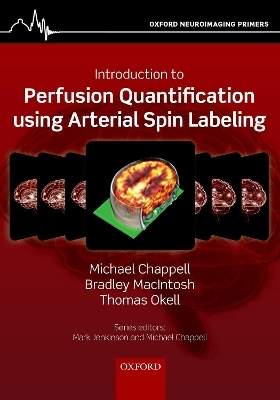
Introduction to Perfusion Quantification using Arterial Spin Labelling
Oxford University Press (Verlag)
978-0-19-879381-6 (ISBN)
Arterial Spin Labeling (ASL) is an increasingly popular tool to study the brain. What sets it apart from other neuroimaging methods is the combination of quantitative measurements of a physiologically well-defined process, namely perfusion, and a completely non-invasive acquisition methodology.
Cerebral perfusion is a critical component to brain health, as it is the primary means to deliver nutrients to support brain function as well as clearing waste products. Hence it is a useful quantity to study in disease where changes in perfusion can indicate regions of the brain that are pathological. Likewise changes in perfusion can be indicative of greater demand for nutrients, such as might be required in response to an increase in neuronal activity.
With the advent of a consensus by the ASL community on good practice and a recommendation on robust methods for ASL data collection, more and more researchers are now able to access and use ASL. Despite the technological advances, ASL remains a technique with a low signal to noise ratio. This makes the wise choice of the appropriate analysis methods more important.
The aim of this primer is to equip someone new to the field of perfusion imaging and ASL with the knowledge not only to make good choices about ASL acquisition and analysis, but also to understand what choices they are making and why. Examples of analysis applied to real data are given throughout the text and instructions on how to reproduce the analyses are illustrated on the primer website.
Written to provide a stand-alone introduction to perfusion qualification using ASL, this primer also works with other texts in the Oxford Neuroimaging Primers series to provide a comprehensive overview of the increasingly influential field of neuroimaging.
Michael Chappell is head of the Quantitative Biomedical Inference group at the Institute of Biomedical Engineering, University of Oxford. He specialises in methods to infer physiological and metabolic information such as perfusion and pH from medical imaging data. These methods are applied in a wide range of medical applications including stroke, dementia and cancer. Michael is also the Director of Training for the EPSRC-MRC Centre for Doctoral Training in Biomedical Imaging. Prior to working in medical image analysis, Michael did a doctorate in SCUBA diving and for a short while investigated methods to identify buried objects such as landmines. Brad MacIntosh runs a lab focused on perfusion and vascular imaging at Sunnybrook Research Institute, University of Toronto. Brad pursued Masters and PhD work in the department of Medical Biophysics at the University of Toronto and Western University. His postdoc was at the FMRIB Centre in Oxford. Brad works on clinical translation of BOLD and ASL functional MRI to a wide range of brain diseases. He also uses these techniques to understand the acute and chronic effects of aerobic exercise on the brain. Thomas Okell is the head of neurovascular imaging research within the physics group at the Oxford Centre for Functional MRI of the Brain (FMRIB). His research focuses on the development of non-invasive MRI methods to visualise the flow of blood through the arteries and the resulting perfusion of the brain tissue. These methods are being applied in a range of patient groups, including those with acute stroke and arteriovenous malformation. Thomas is also the director of physics education for the FMRIB graduate program. He trained as a medical physicist within the NHS before discovering the joys of arterial spin labelling during his PhD.
1: Introduction
2: ASL acquisition principles
3: Preprocessing
4: Kinetic modelling
5: Calibration: Estimating arterial blood magnetization
6: Partial Volume Effects
7: Using ASL to measure perfusion changes in an individual: task-based ASL and beyond
8: Using ASL to measure perfusion in and between groups of individuals
| Erscheinungsdatum | 27.10.2017 |
|---|---|
| Reihe/Serie | Oxford Neuroimaging Primers |
| Verlagsort | Oxford |
| Sprache | englisch |
| Maße | 170 x 242 mm |
| Gewicht | 294 g |
| Themenwelt | Geisteswissenschaften ► Psychologie ► Biopsychologie / Neurowissenschaften |
| Medizin / Pharmazie ► Medizinische Fachgebiete ► Neurologie | |
| Medizinische Fachgebiete ► Radiologie / Bildgebende Verfahren ► Kernspintomographie (MRT) | |
| Naturwissenschaften ► Biologie ► Zoologie | |
| Technik | |
| ISBN-10 | 0-19-879381-2 / 0198793812 |
| ISBN-13 | 978-0-19-879381-6 / 9780198793816 |
| Zustand | Neuware |
| Informationen gemäß Produktsicherheitsverordnung (GPSR) | |
| Haben Sie eine Frage zum Produkt? |
aus dem Bereich


